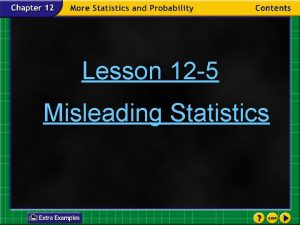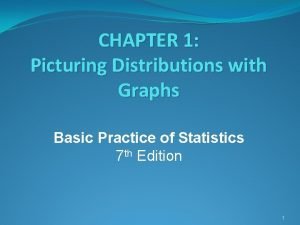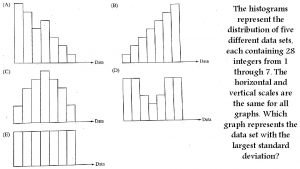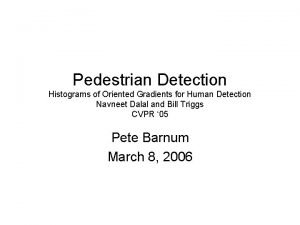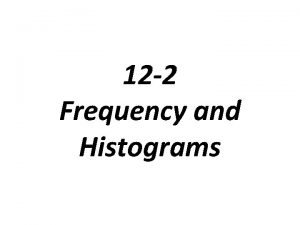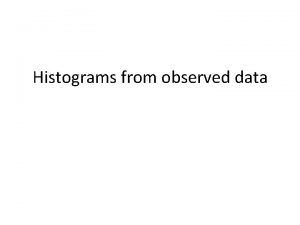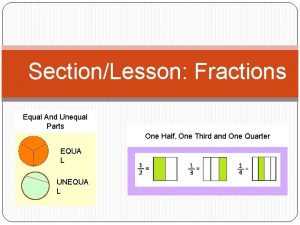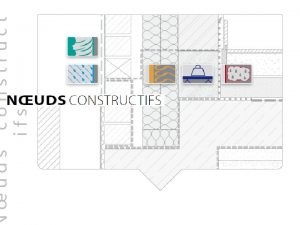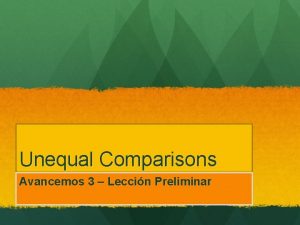Grade A Histograms with unequal class widths Construct




















- Slides: 20

Grade A Histograms with unequal class widths Construct and interpret histograms with unequal class widths (for grouped discrete as well as continuous data) If you have any questions regarding these resources or come across any errors, please contact helpful-report@pixl. org. uk

Key Vocabulary Frequency density

Histograms are a little like bar charts, but with some crucial differences: • There are no gaps between the bars • The bars can be of different widths • The frequency is proportional to the area of the bars. Abar chart frequency is proportional to the height of the bars.

Worked example 1 – drawing a histogram This frequency table gives the weekly wage of 72 accountants Weekly Wage £ 100 < wage < £ 300 ≤ wage < £ 400 ≤ wage < £ 500 ≤ wage < £ 550 ≤ wage < £ 600 ≤ wage < £ 800 Frequency 10 10 20 20 10 2 The first thing we do is add 2 columns (sometimes this is already drawn in for you)

Setting up the table As frequency is proportional to the area of the bar, we need to know how wide the bar is going to be and therefore, we need to know the class width. Weekly Wage £ 100 < wage < £ 300 ≤ wage < £ 400 ≤ wage < £ 500 ≤ wage < £ 550 ≤ wage < £ 600 ≤ wage < £ 800 Frequency 10 10 20 20 10 2 Class Width Frequency density Area = base x height We call the height the frequency density, and find it by dividing frequency by class width Frequency density = frequency / class width

Completing the table First we fill in the class width column Weekly Wage £ 100 < wage < £ 300 ≤ wage < £ 400 ≤ wage < £ 500 ≤ wage < £ 550 ≤ wage < £ 600 ≤ wage < £ 800 Frequency 10 10 20 20 10 2 Class Width 200 100 50 50 200 Frequency density

Completing the table Finally, we work out the frequency density column Weekly Wage £ 100 < wage < £ 300 ≤ wage < £ 400 ≤ wage < £ 500 ≤ wage < £ 550 ≤ wage < £ 600 ≤ wage < £ 800 Frequency 10 10 20 20 10 2 Class Width 200 100 50 50 200 Frequency density 10/200 =0. 05 10/100 = 0. 1 20/100 = 0. 2 20/50 = 0. 4 10/50 = 0. 2 2/200 = 0. 01 Frequency density = frequency / class width

Drawing the Histogram We look at the largest value in the frequency density column. Weekly Wage £ 100 < wage < £ 300 ≤ wage < £ 400 ≤ wage < £ 500 ≤ wage < £ 550 ≤ wage < £ 600 ≤ wage < £ 800 Frequency 10 10 20 20 10 2 Class Width 200 100 50 50 200 Frequency density 10/200 =0. 05 10/100 = 0. 1 20/100 = 0. 2 20/50 = 0. 4 10/50 = 0. 2 2/200 = 0. 01 This = 0. 4, and tells us to label the vertical axis from 0 to 0. 4 The horizontal axis represents our wages, which go from 0 to 800

Drawing the Histogram 0. 4 0. 3 0. 2 0. 1 0 0 100 200 300 400 500 600 700 800

Worked example 2 – calculating frequency density from a histogram Sometimes we are asked to complete a table from a histogram Sometimes the graph itself is incomplete

This is a histogram, complete in every detail. To draw up a table, follow the following steps 0. 4 0. 3 0. 2 0. 1 0 0 100 200 300 400 500 600 700 800

Example 2 Copy the class widths into a table

Example 2 Now read off the frequency density and enter it into the table

Example 2 Finally multiply the frequency density by the class width to find the frequency Weekly Wage £ 100 < wage < £ 300 ≤ wage < £ 400 ≤ wage < £ 500 ≤ wage < £ 550 ≤ wage < £ 600 ≤ wage < £ 800 Class Frequency Width density 200 0. 05 Frequency 10 100 0. 1 10 100 0. 2 20 50 0. 4 20 50 0. 2 10 200 0. 01 2

Now try this…. The table shows a summary of the marks scored by people in a test. Mark 0 < mark ≤ 30 30 < mark ≤ 50 50 < mark ≤ 60 60 < mark ≤ 80 80 < mark ≤ 100 Frequency 6 32 20 (a) Complete the frequency table (you will need to use the histogram on the next slide) (b) Complete the histogram

Now try this….

Now try this…. solution Add two columns and calculate the frequency density for the data we have in the table Mark 0 < mark ≤ 30 30 < mark ≤ 50 50 < mark ≤ 60 60 < mark ≤ 80 80 < mark ≤ 100 Frequency 6 32 20 Class width 30 10 20 Frequency density 0. 2 3. 2 1 The interval 60 < mark ≤ 80 has a frequency density of 1. As this interval has already been plotted, this enables us to write a frequency density scale on the histogram.

Now try this…. 3 2 1 0

Solution Now we can have a scale, we can read off the frequency density for the gaps in the table

Finally, complete the histogram 3 2 1 0
 Histogram with unequal class width
Histogram with unequal class width How to calculate frequency density
How to calculate frequency density Spiral square root
Spiral square root Frequency tables and histograms 14-5
Frequency tables and histograms 14-5 Misleading histograms
Misleading histograms Histogram worksheet with answers
Histogram worksheet with answers Histogram graphing calculator
Histogram graphing calculator Lesson 9-3 histograms and box plots
Lesson 9-3 histograms and box plots Box plots dr frost
Box plots dr frost Picturing distributions with graphs
Picturing distributions with graphs Histograms of oriented gradients for human detection
Histograms of oriented gradients for human detection The histograms below represent the distribution of five
The histograms below represent the distribution of five Histograms of oriented gradients for human detection
Histograms of oriented gradients for human detection Frequency table
Frequency table 12-2 frequency and histograms worksheet answers
12-2 frequency and histograms worksheet answers Histograms
Histograms Does africa have water
Does africa have water Fractions equal and unequal parts
Fractions equal and unequal parts Colpa aurea wasp
Colpa aurea wasp Unequal heating
Unequal heating Why is water pollution a great concern in southwest asia
Why is water pollution a great concern in southwest asia




